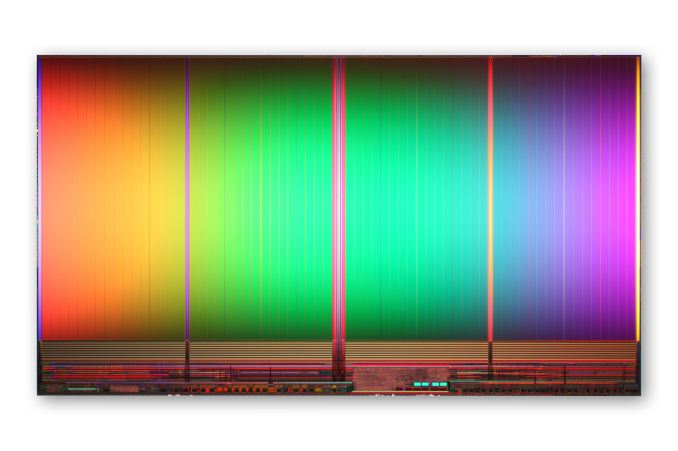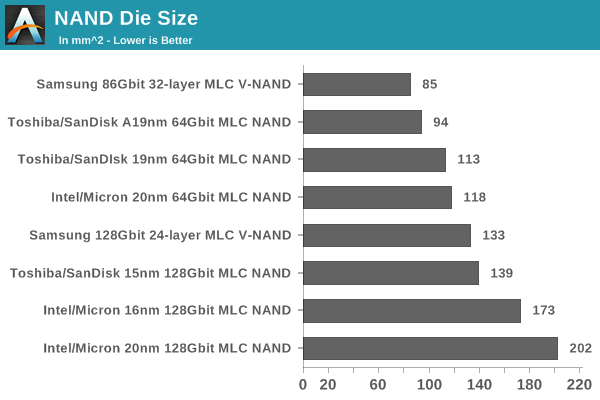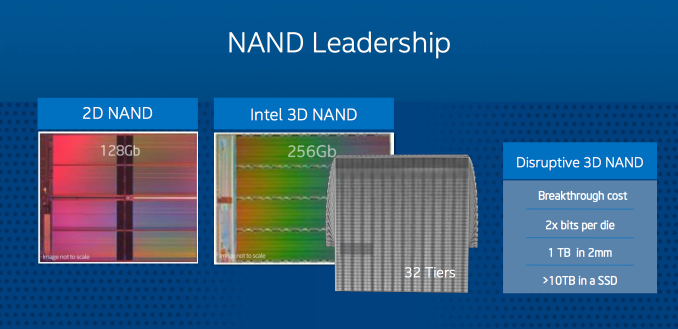Intel's 3D NAND to Ship in H2'15: 256Gbit Die & 32 Layers
by Kristian Vättö on November 25, 2014 5:20 AM EST
Last Thursday in its annual Investor Meeting Intel revealed the first details of its 3D NAND technology and announced that it will begin the shipments of 3D NAND in the second half of 2015. While Intel's investment in 3D NAND hasn't been a secret, the company has been relatively quiet about any specifics and the vital specs such as the number of layers and die capacity have remained unknown. In Thursday's webcast, Rob Crooke, Senior VP and General Manager of Intel's non-volatile memory group, disclosed that Intel's first generation 3D MLC NAND die will be 256Gbit (32GB) in capacity and will consist of 32 layers. The technology also enables a 384Gbit (48GB) TLC (3-bit-per-cell) die as we have learned over the years.
Intel claims that its 3D NAND is the most cost effective on the market and bases this on the fact that its die is 256Gbit whereas Samsung's is only up to 128Gbit at the moment. I'm not sure if I buy Intel's claim because while it's true that a higher capacity die results in higher array efficiency (i.e. peripheral circuitry takes less area), Samsung consciously went from a 24-layer 128Gbit MLC die to a 32-layer 86Gbit MLC die. In other words, Samsung could have upped the die capacity to ~170Gbit by just adding the extra layers, but the company chose to go with a smaller die instead. Smaller capacity dies have advantages in performance (higher parallelism) and applicability because eMMC/microSD devices have very strict die size constraints, so that might be a part of the reason why Samsung's strategy is so different from Intel's and Micron's.

As the graph above shows, Intel's/Micron's NAND dies have historically been larger than the competitors', so the die capacity alone isn't enough to dictate whether Intel's 3D NAND is more cost efficient than Samsung, especially because both have 32 layers. Unlike Samsung, Intel didn't reveal the lithography that is used to manufacture the 3D NAND, but I would say it's safe to assume that the lithography is in the order of 30nm or 40nm because the whole idea of 3D NAND is to move away from multi-patterning to cut costs and with today's technology the smallest pitch of single-patterning is somewhere between 30nm and 40nm. Either way, it will be very interesting to see how Intel's 3D NAND stacks up against Samsung's because there are also some structural differences that affect the production cost as well as performance and endurance, but I'll save the structural analysis for a future article.
Intel said that 3D NAND technology will enable +10TB SSDs in the 'next couple of years', but it wasn't clear whether that is with first generation 3D NAND or some later generation with more layers and higher die capacity. Currently Intel's lineup tops out at 2TB (P3700 & P3600) with a 128Gbit die, so the 256Gbit die alone isn't enough to bring the capacities above 10TB. With effective controller development it should certainly be possible to build a 10TB SSD with a 256Gbit die, although I'm still inclined to believe that Mr. Crooke was referring to second or third generation 3D NAND with his statement.
Similar to Intel's previous NAND efforts, 3D NAND has been jointly developed with Micron and will most likely be manufactured in the co-owned Utah plant as Intel sold its share in other fabs a couple of years ago. Interestingly enough, Mr. Crooke said that they also have the ability to bring 3D NAND production to an Intel fab, although to me that sounded more like a statement of technological possibility rather than a hint of future strategy. I wouldn't rule it out, though, but like Mr. Crooke said in the Q&A, Intel needs to have significant competitive advantage for it to make sense. In the past Intel's NAND technologies have generally been slightly ahead of the rest of the industry, but at least as of now Intel doesn't seem to have any substantial advantage in 3D NAND technology as Samsung is already shipping a 32-layer die and will likely ship a 48-layer die before Intel ships its 32-layer product.
All in all, we'll likely get more crumbs of information as the second half of 2015 gets closer. Given Intel's recent SSD strategy, I expect 3D NAND to first find its way to enterprise-class SSDs, but we'll see soon enough.












58 Comments
View All Comments
Greg100 - Tuesday, November 25, 2014 - link
+10TB SSDs in the 'next couple of years' is all right, but when we see true 2TB or 4TB SSD? I know about 2TB (P3700 & P3600), but they are very expensive and energy hungry. I would like something 4TB with price 4 x Samsung SSD 840 EVO 1TB or 2TB with price 2 x of that Samsung. Of course it would be SATA3 or SATA Express.Kristian, could you please ask Intel, Samsung or other manufacturer about +2TB SSDs? I am waiting for announced 2TB ADATA SSD, but maybe I should wait for some 3D NAND SSD?
Kristian Vättö - Tuesday, November 25, 2014 - link
Manufacturers like Intel and Samsung are not really interested in 2TB client SSDs yet because they are such a small niche (yes, I've talked to them). We'll probably see some 2TB SSDs next year as Phison's S10 supports up to 2TB and so will the SF-3700 when it finally comes.nathanddrews - Tuesday, November 25, 2014 - link
This is probably like wanting to eat my cake and still have it, but a 2TB SSD for under $500 is what I want more than any other upgrade. $0.25/GB... 2015?RussianSensation - Thursday, November 27, 2014 - link
It's possible by 1H 2016. Right now the 1TB Samsung 840 EVO is going for $360.http://www.amazon.com/Samsung-2-5-Inch-SATA-Intern...
The bigger limitation is if consumer SSDs will scale to 2TB by end of 2015. I think we'll be able to buy a 1TB drive for $250 by end of 2015 but not sure if there will be 2TB high performance drives like Samsung 860 Pro. 850 EVO hasn't even launched so it's doubtful that we'll see $500 for 2TB from any reasonably fast drive. The top of the line drives like SanDisk Extreme Pro and 850 Pro are just now hitting $185-275 for 480-512GB sizes.
SandDisk actually believes 10TB by 2016 is too slow:
"Intel is well behind the curve with its 10TB flash drive, slated for 2016, claims a SanDisk enterprise storage bigwig, adding that the flash memory storage provider will have a 16TB drive by then.
Brian Cox, SanDisk’s senior director in marketing for enterprise storage, said the company's 4TB drive technology would develop at a 2X/year capacity pace, with an 8TB drive next year, and 16TB in 2016.
What did he think of Intel's 10TB drive news? “I think it'll be late," he said, while talking to El Reg at a recent Gartner Data Centre Summit in London."
http://www.theregister.co.uk/2014/11/25/sandisk_in...
Michael Bay - Saturday, November 29, 2014 - link
Pffft, it`s just a suit talking shit and making promises which you never should believe.Let them put out at least 4Tb first.
rriiicchh - Sunday, November 30, 2014 - link
You mean like the 4Tb drive they released last May!http://www.sandisk.co.uk/enterprise/sas-ssd/optimu...
MrSpadge - Tuesday, November 25, 2014 - link
If you want 2x or 4x the capacity of the current 1 TB drives, simply buy 2 or 4 of them. You don't even need so many 2.5" mounts in your case, as SSDs don't really need mounting (as long as they don't short your mainboard). Buy a PCIe controller card if you run out of SATA ports. It will be very cheap compared to those SSDs.orionz - Tuesday, November 25, 2014 - link
Unless you are talking about a laptop, or a tablet, or a console, or servers stacked in racks with every bay already full.Magichands8 - Tuesday, November 25, 2014 - link
Yeah I'll believe the +10TB SSDs bit when they actually materialize. So far the entire industry has exhibited extraordinarily scant interest in increasing capacity or lowering prices. Similar to Intel's CPU strategy I've been left for years with very little reason or interest in upgrading.cactusdog - Tuesday, November 25, 2014 - link
I don't think that's true. SSDs have been coming down in price over the last couple of years. The Intel 520 SSD is half the price it was just a couple of years ago. A 1TB SSD was $1,000 18 months ago now they are under $500. Generally most drives are well under $1 per GB. I was an early adopter and paid nearly $470 for 100GB OCZ Vertex 2!!!